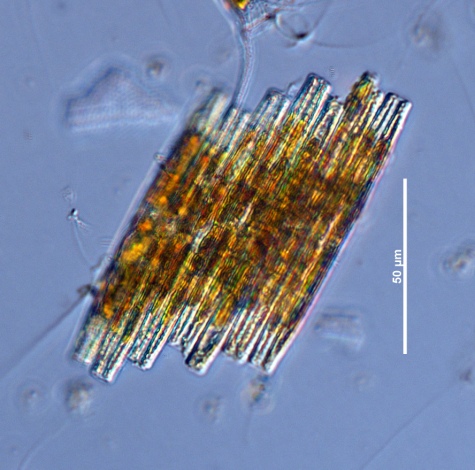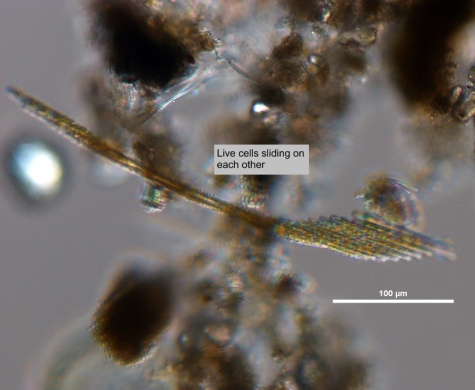


|
Synonym(s)
Homotypic
Expressing the same fundamental type or structure; may or may not be symmetrical (e.g., the two valves of a diatom, where they are the same shape and appearance, but one is bigger than the other). In naming species, a homotypic synonym is one that comes into being when a taxon gets a new name (without being added to an already existing taxon).
(homotypic)Bacillaria paxillifer (O.F. Müller) T. Marsson 1901 (homotypic)
Oscillatoria paxillifera (O.F. Müller) Schrank ex Gomont 1892 (homotypic)
Nitzschia paradoxa (J.F. Gmelin) Grunow 1880 Close
Heterotypic
A difference in type. In naming species, a heterotypic synonym is one that comes into being when a taxon becomes part of a different taxon. Compare to homotypic.
(heterotypic)Nitzschia paxillifer (O.F. Müller) Heiberg 1863 (homotypic)
Diatoma paxillifera (O.F. Müller) Brébisson 1838 (homotypic)
Oscillatoria paxillifer (O.F. Müller) Schrank 1823 (homotypic)
Oscillaria paxillifera (O.F. Müller) Schrank 1823 (homotypic)
Bacillaria paradoxa J.F. Gmelin 1791 (heterotypic)
Vibrio paxillifer O.F. Müller 1786 Close
Basionym
The original name for an organism. In botany, the original published nomenclature from which a new binomial nomenclature is derived for a particular group of organisms (Tindall 1999).
(basionym, homotypic)(Guiry and Guiry 2012)
Classification
(Guiry and Guiry 2012)
Lifestyle
Description
Girdle
In diatoms, the portion of the cell wall between the two valves of a cell; made up of intercalary bands (bands closest to the valves) and connecting bands (bands in the middle of the girdle). In dinoflagellates, the equivalent of a cingulum or transverse furrow (Horner 2002).
girdle view (when in colonies), and lanceolate in valve view (Cupp 1943). CloseRaphe
"In some pennate diatoms, one or two longitudinal slits along the [long] axis or around the valve margins" (Horner 2002). Secretion of mucilage allows a pennate diatom to attach itself to or glide on a substrate (Regents of the University of California 2006).
Raphe system is slightly keeled and runs from pole to pole (Hasle and Syvertsen 1997). Two large plate-like chloroplasts are present, one near each end of the cell (Horner 2002, Kraberg et al. 2010). The CloseNucleus
(plural: nuclei) In eukaryotic cells, a membrane-bound organelle that contains the cell's genetic information; the nucleus controls the activities of the cell by controlling gene expression.
nucleus is located centrally (Cupp 1943). Cells are yellow-brown in colour.Striae
(referring to pores in diatoms) In diatoms, a striation or row of pores on the valve face. "In centric diatoms, striae may be radial, running from the centre of the valve to the margin ... In pennate diatoms, striae may be parallel to the median line of the valve or raphe" (Horner 2002).
striae (Hasle and Syvertsen 1997).Measurements
Apical
(axis, spine) The region of the apex or point. Refers to the most anterior point or region of the cell (HPP 2003).
(apical axis): 70 - 200 μmWidth Close
Transapical axis
In diatoms, the longitudinal axis of the valve.
(transapical axis): 5 - 8 μmHeight Close
Pervalvar axis
The axis through the centre point of the two valves of a frustule. This axis is perpendicular to the valve face.
(pervalvar axis): 5 - 10 μmFibulae: 7 - 9 in 10 μm
Close
Striae
(referring to pores in diatoms) In diatoms, a striation or row of pores on the valve face. "In centric diatoms, striae may be radial, running from the centre of the valve to the margin ... In pennate diatoms, striae may be parallel to the median line of the valve or raphe" (Horner 2002).
Striae: 20 - 21 in 10 μm(Cupp 1943, Hasle and Syvertsen 1997, Kraberg et al. 2010)
Similar species
Harmful effects
Habitat
Distribution
Cosmopolitan (Hasle and Syvertsen 1997).
Present throughout the year with higher abundance in winter and spring in Northern European seas (Kraberg et al. 2010) and in the rivers of SE Iraq (Hameed 2003). Most abundant during the summer in northern Japan (Kasim and Mukai 2006) and during the fall in southern Korea (Yoon and Koh 1995).
Relatively rare in BC waters, but more abundant during spring and early summer.
Growth conditions
Environmental Ranges
Temperature range (°C): 0.015 - 24.625
Nitrate (μmol L-1): 1.640 - 12.045
Salinity: up to 37.775
Oxygen (mL L-1): 4.855 - 8.067
Phosphate (μmol L-1): 0.210 - 0.630
Close
Silicic acid
A general term to describe chemical compounds containing silicon, oxygen and hydrogen with a general formula of [SiOx(OH)4-2x]n. Diatoms polymerize silicic acid into biogenic silica to form their frustules (Azam and Chisholm 1976).
Silicate (μmol L-1): 1.595 - 7.103(OBIS 2012, cited in EOL 2012)
Bloom characteristics
References
Blinn, D. W. and Bailey, P. C. E. 2001. Land-use influence on stream water quality and diatom communities in Victoria, Australia: a response to secondary salinization. Hydrobiologia. 466: 231-244.
Cupp, E. E. 1943. Marine Plankton Diatoms of the West Coast of North America. University of California Press. Berkeley, California. 238.
Encyclopedia of Life (EOL). 2012. Bacillaria paxillifer. http://eol.org/pages/915516/overview. Accessed 06 Apr 2012.
Guiry, M. D. and Guiry, G. M. 2012. Bacillaria paxillifera (O. F. Müller) T. Marsson. http://www.algaebase.org/search/species/detail/?species_id=33212. Accessed 06 Apr 2012.
Hameed, H. A. 2003. The colonization of periphytic diatom species on artificial substrates in the Ashar canal, Basrah, Iraq. Limnologica - Ecology and Management of Inland Waters. 33(1): 54-61.
Hasle, G. R. and Syvertsen, E. E. 1997. Marine diatoms. In: Tomas, C. R. (ed.) Identifying Marine Phytoplankton. Academic Press, Inc., San Diego. 5-385.
Horner, R. A. 2002. A Taxonomic Guide To Some Common Phytoplankton. Biopress Limited, Dorset Press, Dorchester, UK. 200.
Kasim, M. and Mukai, H. 2006. Contribution of benthic and epiphytic diatoms to clam and oyster production in the Akkeshi-ko Estuary. Journal of Oceanography. 62: 267-281.
Kraberg, A., Baumann, M. and Durselen, C. D. 2010. Coastal Phytoplankton: Photo Guide for Northern European Seas. Verlag Dr. Friedrich Pfeil, Munchen, Germany. 204.
Ocean Biogeographic Information System (OBIS). 2012. Bacillaria paxillifer. http://www.iobis.org/mapper/?taxon_id=409077. Accessed 06 Apr 2012.
Redekar, P. D. and Wagh, A. B. 2000. Growth of fouling diatoms from the Zuari estuary, Goa (West coast of India) under different salinities in the laboratory. Seaweed Research and Utilisation. 22(1-2): 121-124.
Yoon, Y. H. and Koh, N. P. 1995. Studies on the environmental characteristics of the breeding ground in the Kogum-sudo, southern part of Korean peninsula. 1. Seasonal succession of phytoplankton population. Korea Inter-University Institution of Ocean Sciences. 27: 116-127.
